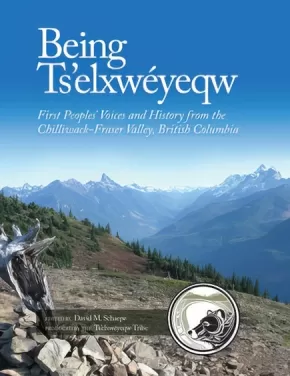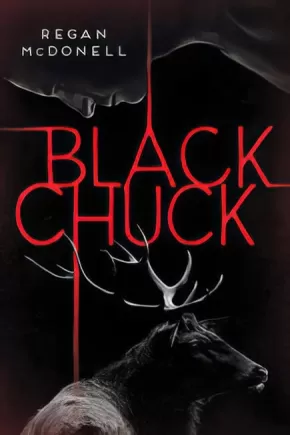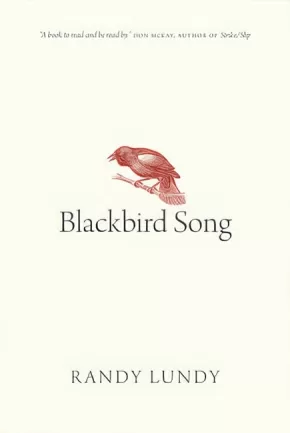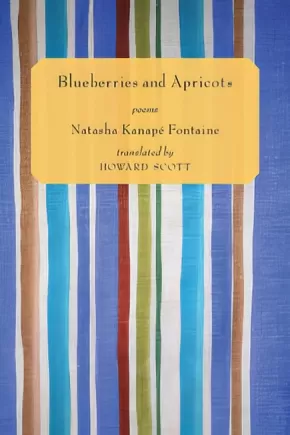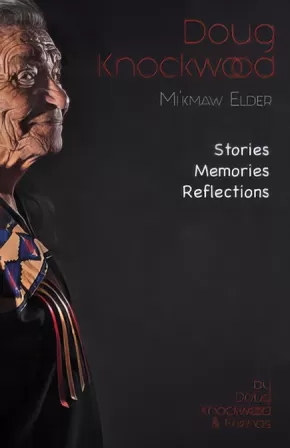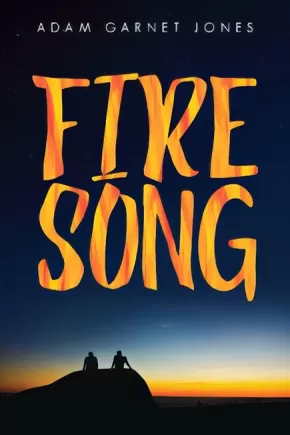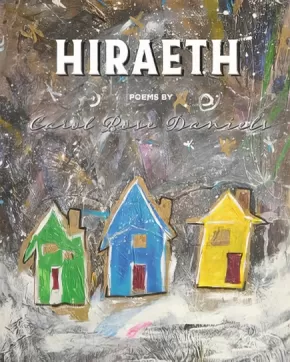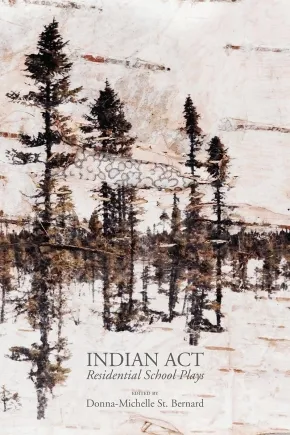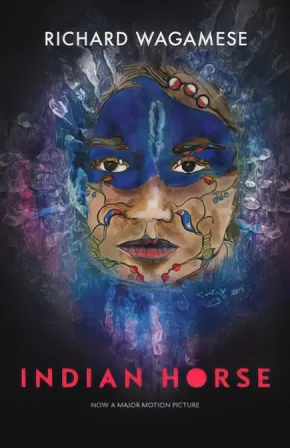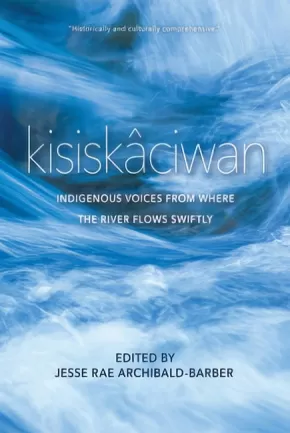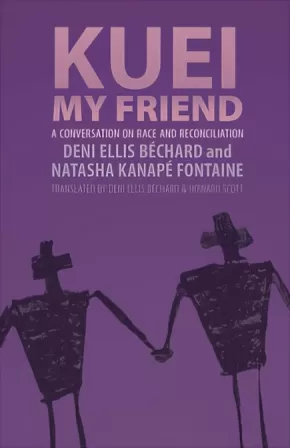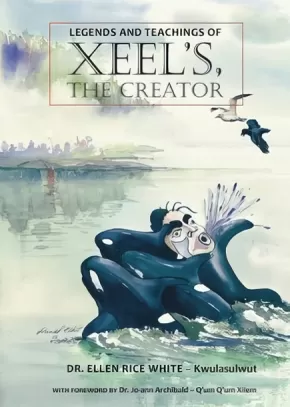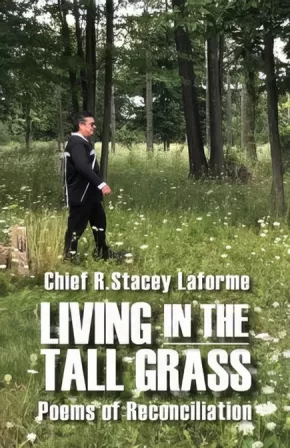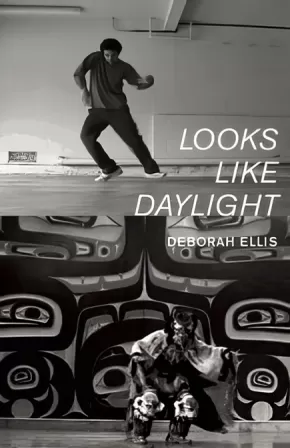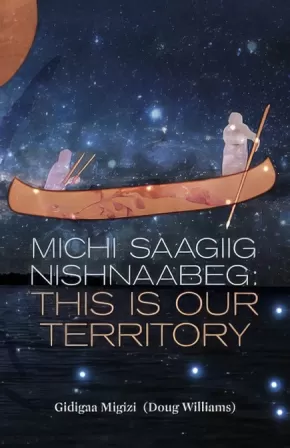Canadian Indigenous Books for Schools
Synopsis:
“Our stories identify for us the land which surrounds us and tie us to our ancestors. We find ourselves inextricably linked to the past, to the land, to the river, to each other, to the future.” —Shirley Hardman, contributor
This impressive volume tells of the First Peoples of the area through vivid narratives from the past and present.
The traditional territory of the Ts’elxwéyeqw First Peoples covers over 95,000 hectares of land in Southwestern BC. It extends throughout the central Fraser Valley, encompassing the entire Chilliwack River Valley (including Chilliwack Lake, Chilliwack River, Cultus Lake and areas, and parts of the Chilliwack municipal areas). In addition to being an area of natural beauty and abundant resources, it also has a rich cultural history. The Chilliwack region gets its name from the Ts’elxwéyeqw tribe, and this volume delves into what this name means—and also what it means to be Ts’elxwéyeqw. Being Ts’elxwéyeqw portrays the people, artifacts and landscapes that are central to the Ts’elxwéyeqw people, and represents a rich oral record of an aboriginal heritage that has been kept alive—even through adversity—for thousands of years.
Lavishly illustrated with over seven hundred historic and current photos and maps, this book amalgamates a variety of voices and personal histories from elders, while providing background into eighty-five place names within the region. The book’s unique composition—with an emphasis on visual storytelling—showcases a culture with a deep connection to the surrounding land and the watershed.
Educator Information
Recommended for Grades 5-12 for the following subject areas: Geography, Social Studies, Science. Also a useful Teacher Resource.
Note: Educators should pre-read sections of this book that they are considering using from this reference book, as reading levels vary greatly.
Additional Information
304 pages | 11.00" x 14.00"
Synopsis:
Psycho. Sick. Dangerous. Réal Dufresne's reputation precedes him. When the mangled body of his best friend, Shaun, turns up in a field just east of town, tough-as-hell Réal blames himself. But except for the nightmares, all Ré remembers is beating the living crap out of Shaun the night of his death.
Shaun's girlfriend, sixteen-year-old Evie Hawley, keeps her feelings locked up tight. But now she's pregnant, and the father of her baby is dead. And when Réal looks to her to atone for his sins, everything goes sideways. Fast.
The tighter Evie and Réal get, the faster things seem to fall apart. And falling in love might just be the card that knocks the whole house down.
Reviews
"McDonell has captured the brashness and insecurity of adolescence in this gravel-splattering joy-ride. Four teenagers attempt to discern what is real from what is not after trauma threatens to rob them all of their futures." — Karen Nesbitt, author of Subject to Change, November 2017
"[A] beautiful and painful novel…McDonell's background in creative writing and poetry is evident in this excellent debut novel…[Réal] is a character I don't think I've really experienced before…He's a character who I felt bad for, cheered for, wanted to slap at times, and who I needed to see find some hope in life…A strange, brutal, heartbreaking, and strangely uplifting novel about lies, love, friendship, courage, and the struggle to overcome guilt. Recommended."— Rob Bittner, Sense and Sensibility and Stories blog, November 2017
"Superb debut novel; the pain and angst of both Ré and Evie is palpable, and the struggles they face within their respective relationships are real and nuanced…This is a brutal, heartbreaking, and yet strangely uplifting novel about the consequences of lies, the gravity of love, and the courage it takes to prevail over self-condemnation."— Booklist, January 2018
"A book unlike anything I have read before…McDonell has developed characters who are diverse, multidimensional, and flawed, which makes them relatable…Black Chuck is an engaging and diverse book that would be a welcomed additional to any classroom or school library. Highly Recommended. " — CM Magazine, February 2018
"Atmospheric…Ojibwe mythology and language add texture as the mystery surrounding what really happened to Shaun, and who—or what—is at fault, deepens."— Publishers Weekly, March 2018
Educator Information
Recommended Ages: 12+
The Canadian Indigenous Books for Schools recommends this resource for Grades 9-12 for English Language Arts.
Themes: grief, friendship, romance, loyalty, diversity, hallucinations, Wendigo, small-town suspense, coming-of-age.
Additional Information
304 pages | 5.50" x 8.25"
Synopsis:
An exquisite series of meditations on memory, evanescence and the land. Randy Lundy draws deeply from his Cree heritage and equally from European and Asian traditions. Readers will be reminded by turns of Simon Ortiz, P?r Lagerkvist, and Jane Hirshfield. This is the mind of prayer, a seeing and re-seeing of the immense cyclic beauty of the earth.
Reviews
“Lundy has entered the place where the masters reside. His poems join the shades that walk among them. There aren’t many people who get to that place and sometimes it can feel very lonely there, but the masters are saved by the brilliant and humble work they have done, their poems the crevices in our lives where the light shines through." – Patrick Lane, author of Washita
“Randy Lundy’s poems bring forward the spirit of his Cree ancestry, and place our species humbly among the creatures of Earth—who are all observed with deep reverence and perceptive care.” – Don McKay, author of Strike/Slip
“This is the book of poems I’ve been waiting for … His poems burn us, feed us, and make us feel beloved even if we have been broken. Language, as he uses it, holds us and leads us to a place where we can mourn and pray and wonder.” – Lorna Crozier, author of What the Soul Doesn’t Want
Educator & Series Information
The Canadian Indigenous Books for Schools list recommends this resource for Grades 10-12 for English Language Arts.
Caution: Some poems contain content that may cause trigger reactions for readers. Pre-read poems before using them with students.
This work is part of the Oskana Poetry & Poetics series. Publishing new and established authors, Oskana Poetry & Poetics offers both contemporary poetry at its best and probing discussions of poetry’s cultural role. Oskana is the Cree word for "bones," and it is used with the blessing of Elder Noel Starblanket. The name reflects a commitment to speak to the deepest and most urgent issues of our time, including environmental crisis and Indigenous justice.
Additional Information
96 pages | 5.50" x 8.50"
Synopsis:
In this, her third volume of poetry, this Aboriginal writer from Quebec again confronts the loss of her landscape and language.
On my left hip
a face
I walk
I walk upright
like a shadow
a people on my hip
a boatload of fruit
and the dream inside
women and children first
"A cry rises in me and transfigures me. The world waits for woman to come back as she was born: woman standing, woman powerful, woman resurgent. A call rises in me and I've decided to say yes to my birth."
Reviews
"Poetess, painter, actress, slammer ... Natasha Kanapé Fontaine speaks with a soft voice, but her words are powerful. In a few years, the young Innue has become a model for young people and for her community." —La Presse
Educator Information
Recommended in the Canadian Indigenous Books for Schools 2019-2020 resource list as being useful for grades 9-12 for English Language Arts and Social Studies.
Additional Information
72 pages | 5.00" x 7.50" | Translated from French by Howard Scott.
Synopsis:
Freeman Douglas Knockwood is a highly respected Elder in Mi’kmaw Territory and one of Canada’s premier addictions recovery counsellors. The story of his life is one of unimaginable colonial trauma, recovery and hope.
At age 6, Knockwood was placed in the Shubenacadie Residential School, where he remained for a year and a half. Like hundreds of other Mi’kmaw and Maliseet children, he suffered horrible abuse. By the time he reached his twenties, he was an alcoholic. He contracted tuberculosis in the 1940s, had one lung and several ribs removed.
Having hit rock bottom, Knockwood, gained sobriety in his thirties through Alcoholics Anonymous. He went on to become a much sought after drug and alcohol rehabilitation counsellor in Canada. Many of Doug’s initiatives have been implemented across Canada and used by thousands of people, both Indigenous and non-Indigenous. Looking back now, says Doug, “I realize I wasn’t only helping them. They were helping me to gather strength in my presentations, in feeding them the knowledge I received, the same as it was fed to me. That helped me to gain confidence in myself; doing all these things that I didn’t know I could yet do”.
This book is an in-depth look at Doug Knockwood’s life that also casts a wide and critical glance at the forces that worked to undermine his existence and the indomitable spirit of a man who recovered from, yet still struggles to overcome, those forces.
Educator Information
The 2018-2019 Canadian Indigenous Books for Schools list recommends this resource for Grades 10-12 for these subjects: English Language Arts, Social Justice, Social Studies.
Additional Information
128 pages | 6.00" x 9.00" | Written by Doug Knockwood and Friends
Synopsis:
How can Shane reconcile his feelings for David with his desire for a better life?
Shane is still reeling from the suicide of his kid sister, Destiny. How could he have missed the fact that she was so sad? He tries to share his grief with his girlfriend, Tara, but she’s too concerned with her own needs to offer him much comfort. What he really wants is to be able to turn to the one person on the rez whom he loves—his friend, David.
Things go from bad to worse as Shane’s dream of going to university is shattered and his grieving mother withdraws from the world. Worst of all, he and David have to hide their relationship from everyone. Shane feels that his only chance of a better life is moving to Toronto, but David refuses to join him. When yet another tragedy strikes, the two boys have to make difficult choices about their future together.
With deep insight into the life of Indigenous people on the reserve, this book masterfully portrays how a community looks to the past for guidance and comfort while fearing a future of poverty and shame. Shane’s rocky road to finding himself takes many twists and turns, but ultimately ends with him on a path that doesn’t always offer easy answers, but one that leaves the reader optimistic about his fate.
Reviews
“Complex, vulnerable emotion is embedded within the specificity of the writing in this dramatic prose debut. Jones avoids clichés of reservation life, humanizing the stories of how his people reconcile the trauma of suicide, missing family members, same-sex relationships, and the isolation of a community left to fend for itself. A touching story that has been a long time coming for the Indigenous community.” — Kirkus Reviews
“This complex, well-written debut will resonate with young people . . . A great coming-out novel with Native American protagonists; recommended for all teen collections.”— Jill Baetiong, School Library Journal
“A powerful, challenging book that is full of deeply meaningful turns as it boldly encourages living life to the best of one’s abilities.”— Foreword Reviews
"A stunning debut. If you loved the movie Fire Song, get ready to swoon over this movie-to-novel adaptation. The tension, beauty, desperation, hunger for someone, hunger for yourself, a family at the crossroads and a highway that's calling--it's all here. Completely riveting. Completely compelling. Adam Garnet Jones, I would follow you and your characters anywhere. Bravo! A literary and unforgettable masterpiece."— Richard Van Camp, author of The Lesser Blessed
"Fire Song features an Indigenous youth struggling after the suicide of his sister and the lack of support he feels from the relationships with those closest to him. When the character's dreams of University are shattered, and his mother withdraws from the world with grief, we see that difficult decisions are to be made in hopes of an optimistic future." - The Dalai Lama Center
Educator Information
Recommended for Ages 14+ / Grades 9+
Novel Themes: LGBTQ, family relationships, suicide, friendships, acceptance, sexuality, secrets, stereotyping, siblings, diversity, teens, multigenerational, Indigenous.
The Canadian Indigenous Books for Schools list recommends this resource for Grades 10-12 for English Language Arts and Physical and Health Education.
Additional Information
232 pages | 5.50" x 8.25"
A hardcover copy of this book is also available on the Strong Nations website.
Synopsis:
Hiraeth is about women supporting and lending strength and clarity to other women so they know that moving forward is always possible-- and always necessary. It documents a journey of struggle that pertains to a dark point in Canadian history that few talk about and of which even fewer seem aware. Poems speak to the 1960's "scoop up" of children and how this affected the lives of (one or thousands) of First Nations and Métis girls-- girls who later grew to be women with questions, women with wounds, women who felt like they had no place to call home. That is, until they allowed themselves to be open to the courage others have lived and shared. "Hiraeth" is a word that is Celtic in origin and it means looking for a place to belong that never existed. But this place does exist -- in the heart.
Educator Information
The 2018-2019 Canadian Indigenous Books for Schools list recommends this resource for Grades 9-12 for English Language Arts and Social Studies.
Caution: some poems contain depictions of violence and racism and use strong language.
Additional Information
112 pages | 7.50" x 6.00"
Synopsis:
Indian Act is a tribute and thank you to those who survived the Indian Residential School system so that future generations could be free to pursue their lives unhindered by educationally enforced lowered expectations and institutionalized abuse. Plays by contemporary First Nations and Métis playwrights cover the broad scope of residential school experiences, all kinds of characters, and no stereotypes, giving voice to those who could not be heard.
Includes the plays:
Bunk #7 by Larry Guno
God and the Indian by Drew Hayden Taylor
They Know Not What They Do by Tara Began
A Very Polite Genocide or The Girl Who Fell to Earth by Melanie J. Murray
Kihew by Curtis Peeteetuce
Dear Mr. Buchwald by Yvette Nolan
Educator Information
Recommended resource for Grades 10-12 English Language Arts, Drama, and Acting.
Caution: Some plays contain mature subject matters and cover themes of substance abuse, sexual and physical violence, etc. Some plays are not appropriate for high school use and may be better suited for college-level courses.
Additional Information
392 pages | 6.00" x 9.00"
Synopsis:
Saul Indian Horse has hit bottom. His last binge almost killed him, and now he’s a reluctant resident in a treatment centre for alcoholics, surrounded by people he’s sure will never understand him. But Saul wants peace, and he grudgingly comes to see that he’ll find it only through telling his story. With him, readers embark on a journey back through the life he’s led as a northern Ojibway, with all its joys and sorrows.
With compassion and insight, author Richard Wagamese traces through his fictional characters the decline of a culture and a cultural way. For Saul, taken forcibly from the land and his family when he’s sent to residential school, salvation comes for a while through his incredible gifts as a hockey player. But in the harsh realities of 1960s Canada, he battles obdurate racism and the spirit-destroying effects of cultural alienation and displacement. Indian Horse unfolds against the bleak loveliness of northern Ontario, all rock, marsh, bog and cedar. Wagamese writes with a spare beauty, penetrating the heart of a remarkable Ojibway man.
Awards
- 2013 Burt Award for First Nations, Métis, and Inuit Literature
- 2013 First Nation Communities Read Award
Reviews
"Richard Wagamese is a master storyteller, who blends the throb of life with spiritual links to the land, hard work, and culture to find success, his words take you into the soul of Indian Horse, to experience his pain, his growing resentments, his depression, and his fear which has to be faced if he is to regain the joy of life. This book is meant for youth, adults, and elders, to be shared, to be lived, and to be treasured for the clear message of hope and the need to go the distance." — Wawatay News
“…The hockey chapters are compelling; they evoke Sherman Alexie’s fiction that examines contemporary life on American Indian reservations through the lens of basketball. But it is as a story of reconciliation that this novel reveals Wagamese’s masterful subtly…In a single image, Wagamese complicates in blinding ways the entire narrative; in a single page, Indian Horse deepens from an enjoyable read to a gripping critique of Canada.” — Kyle Carsten Wyatt, The Walrus, 2012
Educator Information
Grades 10-12 BC English First Peoples resource for units on Lost People, Reconciliation, and Place-Conscious Learning.
Caution: Substance Abuse, Mature Content
Additional Information
232 pages | 5.50" x 8.50"
This special edition of Richard Wagamese’s novel Indian Horse has been released to coincide with the release of the film Indian Horse in the spring of 2018.
Synopsis:
This groundbreaking anthology from territory that is now Saskatchewan, kisiskâciwan, includes rich oral narratives from Cree, Saulteaux, Nakoda, Dakota, Dene, and Métis cultures; early writings from Cree missionaries; speeches and letters by Treaty Chiefs; stories from elders; archival discoveries; and contemporary literary works in all genres.
Historically and culturally comprehensive, voices include Big Bear, Thunderchild, Louis Riel, Gabriel Dumont, Edward Ahenakew, Maria Campbell, Buffy Sainte-Marie, Rita Bouvier, Harold Johnson, Gregory Scofield, Warren Cariou, Louise Halfe, and many more.
Educator Information
The collected works in this anthology would be useful for high school and college/university courses. All the works in this anthology are connected to Saskatchewan in some way. Some themes include Residential Schools, family, resilience, the Sixties Scoop, and coming of age.
Recommended resource for Grades 10-12 for these subjects: Drama, English Language Arts, Social Studies.
Caution: Some of the works in this anthology contain mature subject matter, such as discussion of abuse, violence, sexuality, etc.
Additional Information
300 pages | 6.00" x 9.00"
Authenticity Note: This work is labelled as containing Authentic Indigenous Text because of the contributions from Indigenous Peoples.
Synopsis:
Kuei, My Friend is an engaging book of letters: a literary and political encounter between Innu poet Natasha Kanapé Fontaine and Québécois-American novelist Deni Ellis Béchard. Choosing the epistolary form, they decided to engage together in a frank conversation about racism and reconciliation.
Intentionally positioned within the contexts of the Idle No More movement, Canada’s Truth and Reconciliation Commission, and the National Inquiry into Missing or Murdered Aboriginal Women and Girls, the letters in Kuei, My Friend pose questions in a reciprocal manner: how can we coexist if our common history involves collective and personal episodes of shame, injury, and anger? how can we counteract misunderstandings of the Other, which so often lead to contempt and rejection? how can we educate non-Indigenous communities about the impact of cultural genocide on the First Peoples and the invisible privileges resulting from historical modes of domination?
In an attempt to open a sincere and productive dialogue, Kanapé Fontaine and Ellis Béchard use their personal stories to understand words and behaviours that are racist or that result from racism. With the affection and intimacy of a friend writing to a friend, Natasha recounts to her addressee her discovery of the residential schools, her obsession with the Oka Crisis of 1990, and her life on the Pessamit reserve. Reciprocating, Deni talks about his father’s racism, the segregation of African-Americans and civil rights, and his identity as a Québécois living in the English-speaking world.
By sharing honestly even their most painful memories, these two writers offer an accessible, humanist book on the social bridge-building and respect for difference. Kuei, My Friend is accompanied by a chronology of events, a glossary of relevant terms in the Innu language, and, most importantly, a detailed teacher’s guide that includes topics of discussion, questions, and suggested reflections for examination in a classroom setting.
Educator Information
Recommended resource for Grades 10-12 in these areas: BC First Peoples, Contemporary Indigenous Studies, English First Peoples, English Studies, Literary Studies.
Includes an Innu-aimun glossary and a teacher's guide to help classroom discussion facilitation.
Recommended in the Canadian Indigenous Books for Schools 2019-2020 resource list as being useful for grades 10 to 12 for English Language Arts and Social Studies.
This resource is also available in French: Kuei, je te salue: Conversation sur le racisme.
Additional Information
176 pages | 6.21" x 8.46" | Translated by & Deni Ellis Béchard & Howard Scott
Synopsis:
Snuneymuxw Elder and storyteller Ellen White shares four stories handed down to her from her grandparents and their ancestors.
Legends and Teachings of Xeel’s, the Creator contains four short stories centering around themes such as communication, connection, teaching and respect. The stories featured include: “The Creator and the Flea Lady, The Boys Who Became a Killer Whale, The Sockeye That Became a Rainbow, and The Marriage of the Seagull and the Crow.” Each story is accompanied by a companion piece developed by the storyteller Ellen Rice White (Kwulasulwut) which provides cultural context and an explanation of some of the lessons found in each story.
In the story “The Creator and the Flea Lady”, a Flea mother asks for help saving her premature infant. The Flea woman is reminded of her connection to the many energies surrounding her by Xeel’s and the energies themselves.
In “Boys Who Became a Killer Whale”, eager learners frustrated with the pace and demeanour of their traditional teachers reach beyond what they know and encounter tragedy.
In both the “Sockeye That Became a Rainbow” and “The Marriage of the Seagull and the Crow”, respect and acceptance of the differences of others are central components of the stories. The protagonists struggle with their relationships and the differences they have with their partners.
Educator Information
Please Note: These are a set of uncensored, traditional stories. The content is meant to provide traditional teachings.
Each of the four stories in the book is accompanied by a discussion piece that provides cultural context and questions for the reader to consider. Huĺq̓ umín̓ um̓ language is used throughout. A glossary can be found at the back of the book.
Some subject matter may not be suitable for some readers.
Recommended in the Canadian Indigenous Books for Schools 2019-2020 resource list as being useful for grades 9 to 12 for English Language Arts.
Additional Information
112 pages | 6.75" x 9.75"
Synopsis:
“We should not have to change to fit into society the world should adapt to embrace our uniqueness.” -- Chief Stacey Laforme
In Living in the Tall Grass: Poems of Reconciliation, Chief Stacey Laforme gives a history of his Anishinaabe people through stories and poetry to let Canadians see through the eyes of Indigenous people. Living in the Tall Grass is written in a way that makes the reader feel he or she might be sitting down with Chief Laforme, sharing experiences from their lives. Some poems share humour, while others express pain, though each comes from the heart.
Reviews
"Laforme is a high-profile leader, attending scores of events, large and small in Ontario and gently reminding listeners that most of the southern part of the province is the traditional homelands of the Mississaugas of the New Credit. True to his belief in the longer-lasting impact of the arts, he’ll often open a speech with a verse. “The future lies in the arts, and it lies in all our youth, not just the Indigenous youth,” he says. “Arts make change … if we can share a moment through the arts whether its song, dance, poetry, painting, it transcends even language barriers." — Steve Milton, The Hamilton Spectator
Educator Information
Recommended for Grades 5-12 for English Language Arts.
Caution: Some poems touch on violence and suicide.
Themes: hope, the environment, Residential Schools.
Additional Information
160 pages | 5.50" x 8.50" | duotone photographs
Synopsis:
After her critically acclaimed books of interviews with Afghan, Iraqi, Israeli and Palestinian children, Deborah Ellis turns her attention closer to home. For two years she traveled across the United States and Canada interviewing Native children. The result is a compelling collection of interviews with children aged nine to eighteen. They come from all over the continent, from Iqaluit to Texas, Haida Gwaai to North Carolina, and their stories run the gamut — some heartbreaking; many others full of pride and hope.
You’ll meet Tingo, who has spent most of his young life living in foster homes and motels, and is now thriving after becoming involved with a Native Friendship Center; Myleka and Tulane, young artists in Utah; Eagleson, who started drinking at age twelve but now continues his family tradition working as a carver in Seattle; Nena, whose Seminole ancestors remained behind in Florida during the Indian Removals, and who is heading to New Mexico as winner of her local science fair; Isabella, who defines herself more as Native than American; Destiny, with a family history of alcoholism and suicide, who is now a writer and powwow dancer.
Many of these children are living with the legacy of the residential schools; many have lived through the cycle of foster care. Many others have found something in their roots that sustains them, have found their place in the arts, the sciences, athletics. Like all kids, they want to find something that engages them; something they love.
Deborah briefly introduces each child and then steps back, letting the kids speak directly to the reader, talking about their daily lives, about the things that interest them, and about how being Native has affected who they are and how they see the world.
As one reviewer has pointed out, Deborah Ellis gives children a voice that they may not otherwise have the opportunity to express so readily in the mainstream media. The voices in this book are as frank and varied as the children themselves.
Educator Information
Recommended for ages 12 and up.
Curriculum Connections: English, Geography, Humanities and Social Studies, Indigenous Studies, Civics and Careers, History
Synopsis:
In this deeply engaging oral history, Doug Williams, Anishinaabe elder, teacher and mentor to Leanne Betasamosake Simpson, recounts the history of the Michi Saagiig Nisnaabeg, tracing through personal and historical events, and presenting what manifests as a crucial historical document that confronts entrenched institutional narratives of the history of the region. Edited collaboratively with Simpson, the book uniquely retells pivotal historical events that have been conventionally unchallenged in dominant historical narratives, while presenting a fascinating personal perspective in the singular voice of Williams, whose rare body of knowledge spans back to the 1700s. With this wealth of knowledge, wit and storytelling prowess, Williams recounts key moments of his personal history, connecting them to the larger history of the Anishinaabeg and other Indigenous communities.
Reviews
"This book gives us an alternative perspective on historical record that is both personal and collective. Doug Williams reminds us of the generations of Indigenous knowledge keepers and of a history that stretches back prior to European contact-including the disruption of contact. This book is his gift to the Michi Saagiig and to all Anishinaabek. It is also a gift to Canadians who want to help decolonize this country. - Armand Garnet Ruffo
"Storytelling is not just a gift. It's not just an art. It's also a responsibility: the weaving together of history, philosophy, culture and humour frequently highlighting a culture's perspective on the world. Doug Williams has been doing this as long as I can remember. He lives the culture, not just talks about it. The people and places he talks about in Michi Saagiig Nishnaabeg are more a part of our history then all the things going on in Ottawa." - Drew Hayden Taylor
Educator Information
Recommended in the Canadian Indigenous Books for Schools 2019-2020 resource list as being useful for grades 9 to 12 for Creative Writing, English Language Arts, Media Studies, and Social Studies.
Additional Information
168 pages | 5.50" x 8.50"

